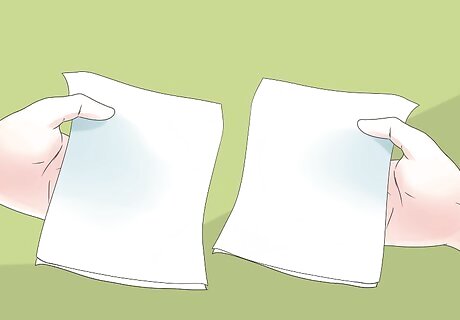
views
Working out the Restatement Basics

Decide on a place for the restatement. Many writers/speakers restate their thesis at the beginning of their conclusion, but it doesn’t necessarily have to be the first sentence. Sketching out a rough conclusion (the main points you want to get across) will give you an idea of the best place for the restated thesis before you actually try your hand at writing the restatement. Depending on the nature of your paper or of your conclusion, you may want to open your conclusion with a question or some other kind of rhetorical device, rather than a restatement of the thesis. While writing often follows prescribed formulas (such as the 5-paragraph essay), there is no one-size-fits-all approach for writing a concluding paragraph, and you may need to try out several positions for your thesis restatement to find out what works best.

Capitalize on the work you’ve done. When your reader read the original thesis in the introduction, s/he hadn’t read the rest of the paper, but now s/he has—use that to your advantage. In restating your thesis, draw on the information you’ve discussed or relationships you’ve established throughout the paper. You can use the restated thesis to provide a greater level of sophistication or emotional impact to the original argument. For example, if your initial argument was that buying pets as holiday gifts is dangerous, you might restate your thesis this way: "Remember: buying that puppy as a Christmas present might seem like a good idea at the time, but it could end in the tragedy of another homeless dog by Easter." You can also restate your thesis to incorporate the relationship you've built with your reader. For example, if your essay was about developing business partnerships, you could begin your restatement by saying something like, "As a businessperson...." Not only will this make your restatement different from the original, but it will also help draw connections with important elements from the essay/speech.

Answer the "So what?" question. A good thesis statement will address the "So what?" question -- in other words, it will explain why your argument is significant. Why should your reader care about your topic? Revisiting this issue in your conclusion will help give your conclusion the weight it needs. For example, if you have written an essay about alcohol use on college campuses, you could revisit the "So what?" question in your conclusion by providing a statement about what that means for students and for college officials. It could look something like this: "Because alcohol abuse depends on more than just the legal drinking age, it is crucial that students be educated about how alcohol abuse occurs, and also that college officials broaden their perspective to include a greater variety of aspects."

Avoid clichés. When beginning your conclusion with the restatement of your thesis, avoid using phrases such as “In conclusion” or “As this paper has shown.” These are tired, overworked phrases that signal to the reader a lack of creativity and originality, rather than a fresh take on what you’ve said in your paper, which is what you want your restatement to achieve. You may be able to use something like “In conclusion” at the end of a speech, however. Signaling or signposting words—like “in conclusion” or “next”—are very important in speeches because listeners only have one chance to follow along with what you’re saying, and these words help them to keep their place.

Don’t apologize. When restarting the thesis, assume that you have proven it over the course of the paper and don’t make apologies or hedge, which will weaken the conclusion and thus the paper. Avoid saying things like, “It seems like” or “It is possible that” in the restatement. One exception would be if this conditional language is part of your original thesis statement and your paper is devoted to discussing a topic that is only a possibility, not something you are stating is definitely the case. Otherwise, maintain a level of confidence. While maintaining confidence is crucial to the success of your paper, it’s important to acknowledge when opposition exists and not to use absolute statements which may alienate readers. Confidence in your position and in the fact that you’ve proven your point is one thing; blind certainty in your opinion is another!
Making the Restatement Distinct from the Thesis

Use different words. Find synonyms for important words and concepts in your original thesis and replace them in your restatement. You can use your word processor’s thesaurus function for this, an online thesaurus, or a good old-fashioned paper thesaurus. If you use a thesaurus, however, check your chosen word in the dictionary to ensure that you know its precise meaning. Thesauruses group words very loosely by general meaning, and there is often a significant difference in connotation between them. It’s not necessary to change every single word, such as prepositions (“in,” “on,” “above,” “over”) and articles (“a,” “an,” and “the”). Spend your time focusing on words/phrases that receive the most emphasis, like those that are central to the points you’re making.

Change the structure. The restatement should be different from the original thesis not only in its language but also in its structure. This applies at the level of clauses (within sentences) and the overall sentence level. Try varying your sentences by starting with different parts of speech. For example, if you began the original thesis with a prepositional phrase, start the restatement with the subject of the sentence. For instance, if the thesis starts out “Around the turn of the nineteenth century in England, women frequently…”, you might start your restatement out with something like “Women in early nineteenth-century….” Another way to vary the structure is to present your points in a different order. Many thesis statements include three ideas, presented in the order in which they will be discussed in the body paragraphs. When restating, you can list the points in an alternate order.

Split the points up. In your introduction, your thesis statement was probably one sentence (or maybe two), with all the points made right in a row. In your restatement you can try splitting your points up across multiple sentences and spreading them out across the paragraph. This will create variety between the thesis and restatement and also allow you to suggest how you have proven the various points throughout the body of the paper.

Change the tense. If you’re writing a speech, your thesis statement was likely written in the future tense, telling your audience what you are about to do over the course of your speech (e.g., “I will analyze the effects of oil drilling”); in your restatement, you should change to the past tense and tell the audience what you already have done (e.g., “I explained how detrimental oil drilling is for wildlife and humans”).




















Comments
0 comment